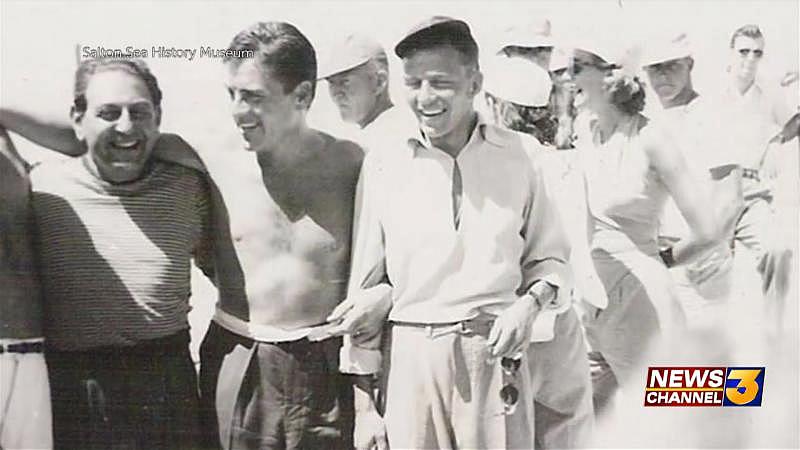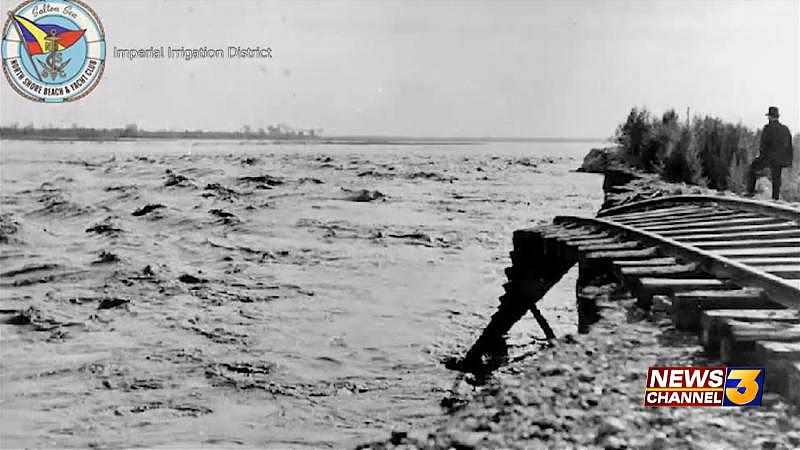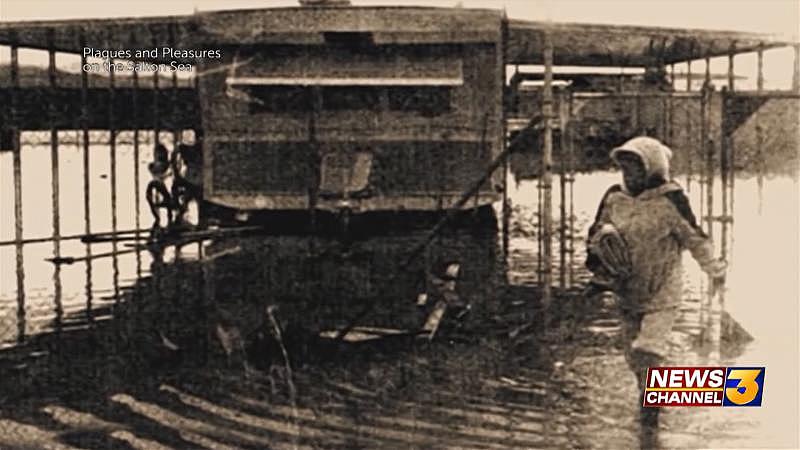Troubled Waters: The Salton Sea Project, Part 1 – Paradise Lost
This story is part of a larger project, "Troubled Water: The Salton Sea Project," led by Angela Chen, a recipient a 2020 Impact Fund grant from the Center for Health Journalism. Chen is examining the health and environmental risks linked to the decline of the Salton Sea.
Other stories include:
Troubled Waters: The Salton Sea Project Part 2 – ‘Toxic Exposure
Troubled Waters: The Salton Sea Project Part 3 – A Lake Languished
Troubled Waters: The Salton Sea Project Part 4 – Salton Sea Plea
Troubled Waters: Extended Interview with Assemblymember Eduardo Garcia
Troubled Waters: Extended Interview with Congressman Raul Ruiz
Troubled Waters: Extended Interview with the Imperial Irrigation District
Half-hour special with all four parts of Troubled Waters
Changes happening at the Salton Sea on a state & federal level
News Channel 3 awarded regional Edward R. Murrow Award for Salton Sea series

Courtesy of the Salton Sea History Museum
Courtesy of the Salton Sea History Museum
Just a short drive south of Palm Springs, you'll find California's largest lake. The drive along the circumference of the Salton Sea reveals surprising, majestic views unlike anything you'd expect to find in the desert. But for its impressive sights and size, the Salton Sea is not a household name, least of all in the very state it's found. These days, if you travel along the increasingly shrinking shorelines, you'll see suffering communities dotted with abandoned homes and lined with silent streets.
But in the 1960s, people could not get enough of the pleasures at the Salton Sea. At the very southern end of the Coachella Valley, people could find a true desert oasis
"We can pack a lunch; we could fish," said Linda Beal of the now-shuttered Salton Sea History Museum. "And then when it got too warm, Dad would say, 'Okay, kids, it's getting warm. Let's jump out, and we'll go waterskiing!'"
Old Hollywood flocked to its shores, with the likes of Frank Sinatra, Desi Arnaz, Jerry Lewis, and the Beach Boys partying at the lake.
Frank Sinatra at the Salton Sea. Courtesy of the Salton Sea History Museum.
It was the glamorous place to see and be seen, according to Michael Karp, an environmental historian and an assistant professor at the CSU San Bernardino Department of History. Hundreds of thousands of people visited the area, attracting more visitors than Yosemite Park at the time. Fishing, water-skiing and boat-racing reigned on high, earning the lake the nickname "the fastest body of water." One area on the western part of the lake, Salton City, became a hot spot for luxury living development.
"Salton City starts to be a part of a real estate craze, and there's another yacht club at Salton City. They start building a PGA golf course out there," Karp said.
But, as we know, it wouldn't come to last, made all the more devastating because of the lake's extraordinary beginnings.
What you see today of the Salton Sea is only the latest reincarnation. In past lives, the lake, known as ancient Lake Cahuilla, has dried up and refilled with Colorado River flood waters many times over thousands of years.
"The current Salton Sea's maximum depth is around 43 feet, and historically, the ancient lake was sometimes over 100 feet deep," Karp said.
The writing is on the wall. The sharp water line visible on the mountains just opposite of Desert Shores today shows just how high the water level of the Salton Sea used to be. At one point, historical records show the Salton Sea was connected to the ocean.
It's in one of these past lives in the 1600s, that the legend of the Lost Ship of the Desert is born.
This was the lost pearl ship of Juan de Iturbe who was this Spanish explorer who was on an expedition and his boat supposedly had gems on it. It's in 1615 that he's exploring the Gulf of California and as the story goes, the tides and conditions are just right that de Iturbe and his crew are somehow able to ride into Lake Cahuilla, and that they explored Lake Cahuilla for a few days to then only find themselves landlocked. They're now stuck and they can't get back out to the Gulf of California, and they have no other choice but to abandon their ship and go back on foot to the closest Spanish settlement, leaving behind their pearls and gems.
- Michael Karp, CSUSB Professor, Department of History
Over the decades, there have been reported sightings in newspapers, of an apparent Viking mast and a gold cross.
"There's been different people that have said they have found these things, you know, little treasure chests boxes -- treasure chests with pearls in them," Beal said.

The legend is exciting to dream about, but Karp, short on evidence, does not believe these romantic stories, saying the lore is based on a novel around the same time. Shifting sands will never tell.
For most of the 1800s, as far as records show, the Salton Sea was mostly a dried up lake bed. The massive lake we know today only came to be because of a mistake in the early 1900s, when the ambitions and ego of one man shaped California's largest lake.
"This really begins with a man named Charles Rockwood. He had this dream of bringing the Colorado River to the Colorado desert in California to try to expand agriculture," Karp said.
Rockwood, joined by George Chaffey, an engineer, built canals to connect water from the Colorado River to farmland. But the best laid plans often get sunk, and in 1905, a flood swelled the Colorado River, overwhelmed the canal, and burst. Waves of water rushed into the Salton Sink, 265 feet below sea level, forming the Salton Sea.
While most loved the lake for its views and water sports on the surface, in the 1940s, the military relished the Salton Sea for its body underneath. A Navy test base was set up at the sea in 1942 for World War II, using it for bombing range operations, rocket development, and testing jet engine propellant mixtures.
The Navy confirms at least 20 warplanes, from Wildcats to Avengers, crashed into these waters. 36 men were killed, with not all bodies accounted for by officials.
The Navy told News Channel 3 it abandoned the base in 1995, but to this day, the lake still hides vast secrets below. Some of those planes and bodies are still trapped down there. Any plane found in the Salton Sea is U.S. property, and better left untouched, especially because of the risk of unexploded ordnances.
Tourism at the Salton Sea would explode in the 1950s, a trend that would continue into the 1970s.
"They actually start to grid streets and put in plumbing so they have lots ready to go but unfortunately, people kind of oversold or they sold too high and even though you have this moment of great popularity and booming time and it starts to comes to an end," Karp said.
It was during this time that everything would start to fall apart. The area saw major flooding in the '70s and '80s, destroying houses, inundating roads, and transforming neighborhoods into unlivable places. Agricultural runoff also poured into the lake, and at one point, there's too much water in the Salton Sea.

"It's in 1985 that the health department comes out to the Salton Sea and conducts a study, and they determine that the fish are unsafe to eat. They put "No Fishing" signs in '85, and the Salton Sea starts to have the environmental problem that we associate with it now today, beginning at this time, and by '85 the tourist industry, the heyday of Old Hollywood is gone," Karp said.
With no fresh water flowing into the lake and the desert's 120 degree summer heat, the water evaporates rapidly, leaving behind a lake that's almost twice as salty as the Pacific Ocean. Dead fish begin to pile up, and bird bodies line the shore.
The shoreline starts to recede, opening up exposed lakebed, full of chemicals and pesticides from farm water runoff.
Decades of doing very little by the government, local tribes, and the water districts, who all own parts of the land, has led to a 2021 Salton Sea that has lost more than 10 percent of its water since 2003, according to the Pacific Institute.
If the lake continues on its current path and nothing major is done, the lake will continue to shrink, exposing more playa, killing off what's left of the wildlife, and spreading toxic dust across the Coachella Valley, San Bernardino and Los Angeles counties, and more.
"Southern California, for potentially millions of people, is going to be a very unpleasant and unhealthy place to live," Karp said.
For those impoverished people living around the Salton Sea, it already is. Cries for help have been drowned out by lip service from those in power. Getting anything major accomplished at the Salton Sea has been a struggle for decades. In the next segment of "Troubled Waters: The Salton Sea Project" airing next Wednesday, Angela Chen will take a look at the environmental and health crises spilling over from the Salton Sea.
You can watch a segment of "Troubled Waters: The Salton Sea Project" every Wednesday in May at 6:00 p.m. on News Channel 3 and CBS Local 2.
[This story was originally published by KESQ.]
Did you like this story? Your support means a lot! Your tax-deductible donation will advance our mission of supporting journalism as a catalyst for change.

